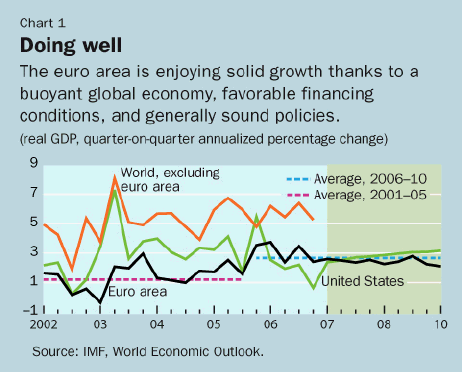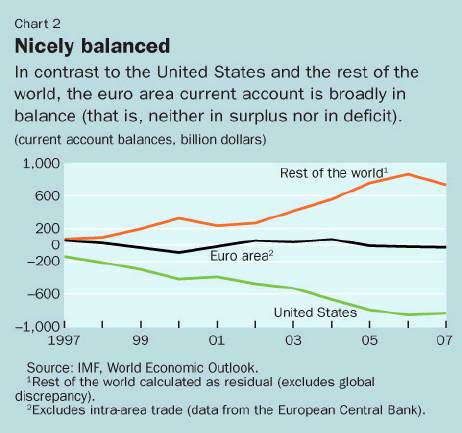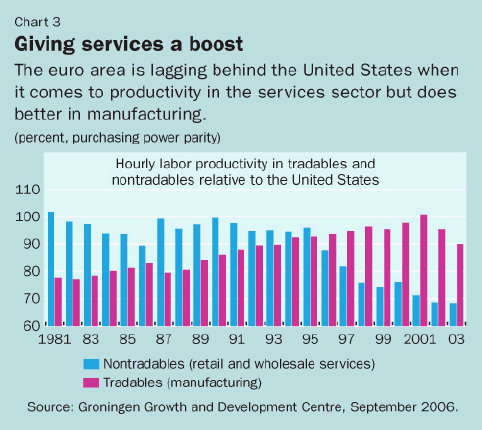ANNUAL ECONOMIC HEALTH CHECK

Typical street scene in Santa Ana, El Salvador. (Photo: iStock)
IMF Survey: Euro Area: From Recovery to Upswing
August 8, 2007
- Economic outlook for 13 countries of euro area is best in years
- But both old and new policy challenges need to be dealt with
- Raising long-term growth calls for more reforms, integration
The euro area is moving into an economic upswing.

Jean-Claude Trichet, ECB President: set to face ongoing challenge of inflationary pressures (photo: Kai Pfaffenbach/ Reuters)
Growth is running at about 2½ percent, and inflation is just under 2 percent (see Chart 1). Government finances are in much better shape than a few years ago. Firms have been expanding and more people are now employed. These results are the fruits of a benign external environment, favorable financing conditions, and generally sound policies the IMF says in its annual "Article IV" consultation with the euro area on the zone's policies and prospects.

The euro area's external position also looks good. In spite of the euro's recent strength, export growth has been dynamic, and the current account balance with the rest of the world is in equilibrium (see Chart 2). All in all, the euro area's external position and currency are within the range of what is consistent with economic fundamentals.

Growth is expected to remain around 2½ percent in 2007 and 2008 and to be accompanied by healthy employment gains, thanks to labor market and welfare reforms and immigration. The short-term risks to this outlook are small and could even be favorable. But some negative surprises could occur over the medium term, especially if the external environment were to worsen unexpectedly.
No letting down guard
Even though the economy is doing better than it has for years, the 13 members of the euro area still face challenges, leaving policymakers with little room for complacency.
As the upswing unfolds and inflationary pressures build, the task of monetary policy will be to stabilize inflation just below 2 percent, which may require more rate hikes. At present, the policy interest rate is 4 percent and thus within what is considered neutral territory. But wage demands may well build as unemployment recedes. And if firms decide to pass on the cost of wage increases to consumers, inflationary pressures could follow.
Judging when and by how much to raise the policy rate to forestall such a development will be an ongoing challenge for the European Central Bank, which sets monetary policy for the euro area. It will depend in part on wages and the extent to which the labor supply has improved, as well as on the pricing behavior of firms and productivity growth.
Fiscal deficit falls
The key challenge for fiscal policy is to keep up recent momentum in improving public finances. So far, fiscal outcomes have been strong. Indeed, standard measures show that the euro area's underlying (or structural) deficit fell by almost 1 percentage point of GDP in 2006.
The euro area finance ministers have declared their intention to build on this improvement and achieve their countries' medium-term budgetary objectives (typically, close to balance or surplus) by 2010 at the latest. But, as the upswing takes hold, pressures to slow adjustment and spend revenue windfalls are increasing, particularly in key countries that have not yet made sufficient headway toward their objectives.
Against this backdrop, policymakers should keep in mind that it makes tremendous sense to consolidate fiscal policy during good times, especially since public expenditure related to population aging will begin to accelerate after 2010.
Advancing reform, integration
The current favorable situation is due in some measure to reforms carried out during the past few years. But although much has already been accomplished, more reforms—including in the context of the European Union (EU)—could help accelerate long-term growth.
On the structural side, the fundamental challenge is to bring about both higher productivity and more employment.
Reforms in labor markets have led to stronger employment performance, but much remains to be done to increase labor participation rates and incentives to work. Also, the euro area's productivity performance is still weak, particularly in services (see Chart 3). This suggests that competition in national markets should be given more play.

The EU Services Directive is a significant step in this direction and, if implemented in good faith, will help member states raise the productivity of their services sectors. More generally, countries need to deliver on the promises they have made in the context of the Lisbon Agenda, the EU's blueprint for improving Europe's long-term growth prospects.
Financial sector integration
Financial sector integration is another key avenue for boosting growth. In recent years, the financial sector has accounted for about half of the euro area's productivity growth gap with the United States. The growth benefits of integration would therefore be particularly large in this sector, and member states should give more play to market forces in retail financial services and further liberalize capital markets. Making progress in this area calls for a consistent implementation of the EU's Financial Services Action Plan and integration of financial infrastructure across the EU.
Liberalization of the financial sector should go hand in hand with a more integration-friendly perspective to the financial stability framework in the euro area. Placing more emphasis on joint responsibility and accountability could help resolve potential problems with large cross-border financial institutions. For more on this topic, please see chapter 1 of the book, Integrating Europe's Financial Markets (forthcoming).
Preparing for rainy day
In sum, policymakers in the euro area have a lot to be proud of, and the good times look set to continue. But now is also the time to attack some of the more deeply entrenched problems in labor markets, services, and the financial sector so that Europe will be ready to tackle the formidable challenges posed by the aging of society.







